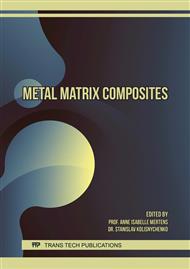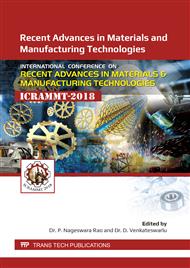p.98
p.104
p.110
p.116
p.122
p.128
p.134
p.140
p.146
Influence of Sic and Al2O3 Particulate Reinforcement on the Mechanical Properties of ZA27 Metal Matrix Composites
Abstract:
Zinc aluminum based matrix composites reinforced with SiC and Al2O3 particles have significant applications in the automobile field. Stir casting method followed by squeeze process was used for fabrication. ZA27 composites reinforced with SiC and Al2O3 particles (20-50µm) in various weight percentage (wt%) ranges from 0-10 in a step of 5 each was fabricated. OM, SEM and EDS analysis of microstructures obtained for matrix alloy and reinforced composites were performed in order to know the effect of varying wt% on physical and mechanical properties of composites. Squeeze casting technique shows better features such as fine microstructure as a result of low porosity and good bonding between matrix and reinforcement. Addition of reinforcements decreased the densities of matrix alloy. SiC reinforced composites showed better results as compared with Al2O3 reinforced ones. Hardness and ultimate tensile strength value of 10 wt% reinforced composites showed improved results.
Info:
Periodical:
Pages:
122-127
Citation:
Online since:
August 2019
Authors:
Keywords:
Price:
Сopyright:
© 2019 Trans Tech Publications Ltd. All Rights Reserved
Share:
Citation:



